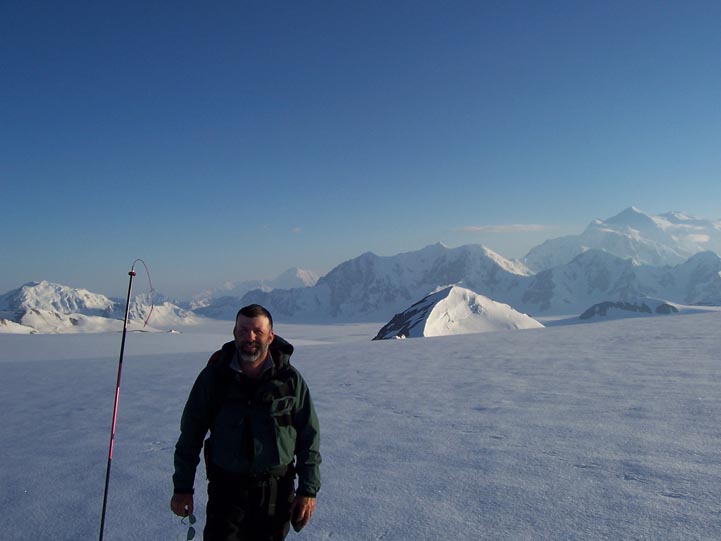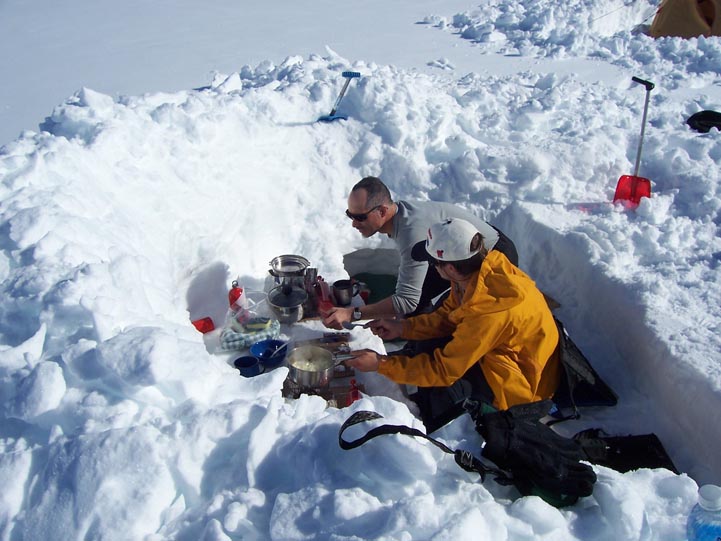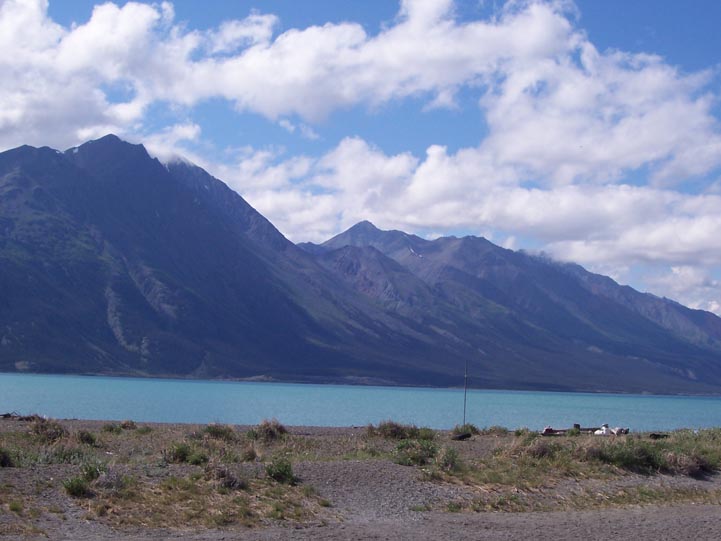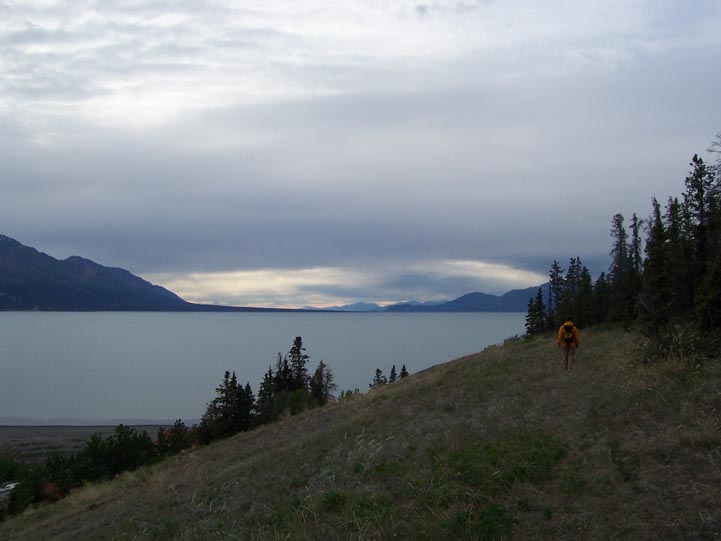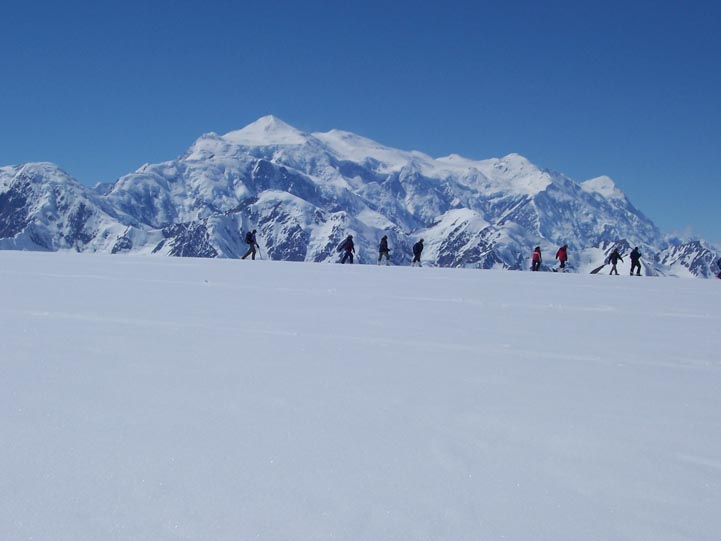Meteorological Controls on Snow Accumulation, St. Elias Mountains
Meteorological Controls on Snow Accumulation, St. Elias Mountains, Yukon Territory, Canada
Alan Wanamaker and Zachary Von Hassein
June 8 – June 27, 2005
The Arctic represents one of the key regions on Earth in our efforts to document and understand global change. The sensitivity of the Arctic to climate perturbations and the wealth of paleoenvironmental records available from this region justifies the prominent role the Arctic plays in global change research. The Arctic is experiencing changes in atmospheric and oceanic circulation related to natural climate variability and to anthropogenic greenhouse gas/sulfate aerosol forcing. These changes extend from the top of the atmosphere to below 1000 m depth in the ocean and include observations of decreased sea ice cover, a rise in the North Atlantic Oscillation atmospheric circulation index, reduced formation of North Atlantic Deep Water, and warming over the subpolar land areas of Alaska and northwest Canada in winter and spring.
To properly interpret glaciochemical records developed from the new St. Elias ice cores, calibration of snow properties with meteorological data (temperature, precipitation, sea level pressure) is critical. At the Divide Site, two automatic weather stations have been operating since 2002, collecting snow depth as well as standard meteorological data. Therefore, the timing of snow accumulation over the past 3 years is known precisely, providing a unique opportunity to investigate the atmospheric controls on snow deposition and chemistry in the St. Elias Mountains. Our first objective is to dig and sample a 6-meter snowpit underneath the AWS station, collect samples for stable isotope, major ion, and trace element analysis, and interpret the physical stratigraphy observed in the snowpit. Our second objective is to return the samples frozen to UMaine, and conduct chemical analysis. Our third objective is to correlate meteorological and snowpit chemical records, and interpret the basic atmospheric processes controlling snowpack properties in the St. Elias.
Fieldwork Details
The fieldwork being conducted is an international collaborative effort among groups from UMaine, the University of Ottawa (UO), and the Geological Survey of Canada. The UMaine group will join Dr. C. Zdanowicz (GSC), who has extensive glaciological research experience in the St. Elias Mountains. The entire team plans to spend roughly 1 week at the Divide site, collecting meteorological data and snow chemistry samples. Based on past experience in the area, our overall schedule includes four anticipated weather delay days.
June 22, 2005
Zach and I are heading into Whitehorse today from Kluane Lake Research Station. We will be flying tomorrow evening, arriving in Boston on the morning of June 24th . We will drive to UMaine and drop of the gear and samples. The analysis of the samples will be carried out over the summer to early fall.
June 18th – 21st, 2005
We returned from the Divide ice field on June 18th , and have been at Kluane Lake Research Station. We have cleaned our gear and organized the samples for transit back to UMaine. The glaciological field camp from the University of Ottawa also finished and came down from the Divide ice field. The weather during these few days has been highly variable making it difficult for Andy to fly into the mountains. He managed to safely get every one down for the celebration of summer solstice, which included a feast for about 40 people and then games on the beach at Kluane Lake.
June 11th – 18th, 2005
The Divide ice field is a beautiful place. We arrived on Saturday morning of the 11th . Shan who runs the base camp at the Divide ice field greeted us. The flight into the mountains was stunning. The St. Elias Mountains are rugged, and the glacial geology is quite incredible.
We set up our tents away from the ice field discovery camp and set up an underground kitchen. We surveyed the condition of the automated weather station (AWS) located at the Divide Site. It was leaning a bit, but still seemed operational. The snow depth sensor was 2 meters above the current snow level. Therefore, it will need to be raised.
The next two days included servicing the AWS. We dug out the cooler, which contained the electronics that ran the station. It was about 3 meters below the surface. As we dug down near the shaft supporting the weather station we noticed that one of the couplings was broken. We replaced the coupling and two sections of pipe. Once the tower was straight and extended vertically for the next snow season, we dug in anchors. These plywood anchors were dug into the ground 2 meters and were attached to the main tower by heavy-duty wire. Christian downloaded the data and charged the batteries for the AWS.
With the AWS at the Divide Site serviced, Zach and I began our snow pit. For the next three days we dug a 5-meter pit and sampled the snow at specific intervals. We dug and cleaned 2 meters at a time. Once the pit was deep enough we put on clean gear (suite, gloves, etc.) and removed ~25 cm of the pit wall with a clean plastic shovel. Once the wall was cleaned, it was scraped with a special plastic material to ensure the pit wall was pristine. We sampled for isotopes and major ions every 5 cm and trace metals every 20 cm. We measured the temperature of the pit wall and its density every 10 cm. In addition, we described the stratigraphy of the pit wall, which generally included ice layers, ice lenses, and the physical characteristics of the snow (e.g., granular snow, coarse grained snow, dirty horizon, etc.) We continued this process until we completed 5 meters.
Christian checked out the other AWS located on a nunatak about 30-40 minutes our tent site. It appeared to be operational and needed only minor servicing. After completing our snow pit, Zach and I snow shoed out to the second AWS and checked it out.
We completed our work and awaited transport back to Kluane Lake Research Station. With all of our gear and tents packed and ready for transport, Andy flew overhead but did not land. We learned that he needed to replace a part and was unable to safely land and pick. After a trip to Whitehorse and having a part machined on the spot, he back flying in two days. We came out on Saturday the 18th.
The weather at the Divide Site was rather warm in the daytime (~ 10 to 15 Celsius) and not that cold at night (~ 0 to -10 Celsius). We had two fresh snow events during the night, but they did not amount to much. One day involved whiteout conditions with snow, rain, fog, and relatively strong winds. And to our surprise, a lone wolf traveled across the Divide ice field not too far from our base camp.
June 10, 2005
We had a great night sleep in our rustic cabin. We joined the other folks for breakfast. The weather did not look all that great in the morning with lots of low clouds. There was not much wind, and it was pleasantly cool enough for a light fleece shirt. The weather improved by late morning and Andy began flying folks into the Divide site.
Zach, Christian, and I sorted our gear and food and prepared it for the flight. We cut new plywood anchors for the weather station at the Divide site. We set up our tents and checked our gear one more time to make sure everything was ready. About half of the Univ. of Ottawa folks have been flown to the Divide site. If the weather allows, we may fly in tomorrow.
June 9, 2005
We met Christian this morning for breakfast. We shopped for supplies and food in Whitehorse. We departed for Kluane Lake Research Station in the early evening. The drive was about 3 hrs long, and was incredibly beautiful. We saw a coyote along the roadside, and a black bear cub too.
Erich Osterberg just came down from his last field site, so we had a chance to talk with him about conditions on the mountain. We met Lance (he runs the base camp at Kluane) and Andy (Director and Master bush pilot), and the folks from the University of Ottawa. They are conducting a glaciological field camp at the Divide ice field. They hope to go to the ice field tomorrow if the weather cooperates. We watched the sun set over Kluane Lake and the St. Elias Mountains at 11:30 pm local time.
June 8, 2005
Zach and I arrived in Whitehorse Canada as scheduled without any problems. Our luggage and sampling gear made it as well. In the morning we will meet Christian Z. from CGS and shop for food and supplies. It is rather warm (~75° F) in Whitehorse, with clear skies.


